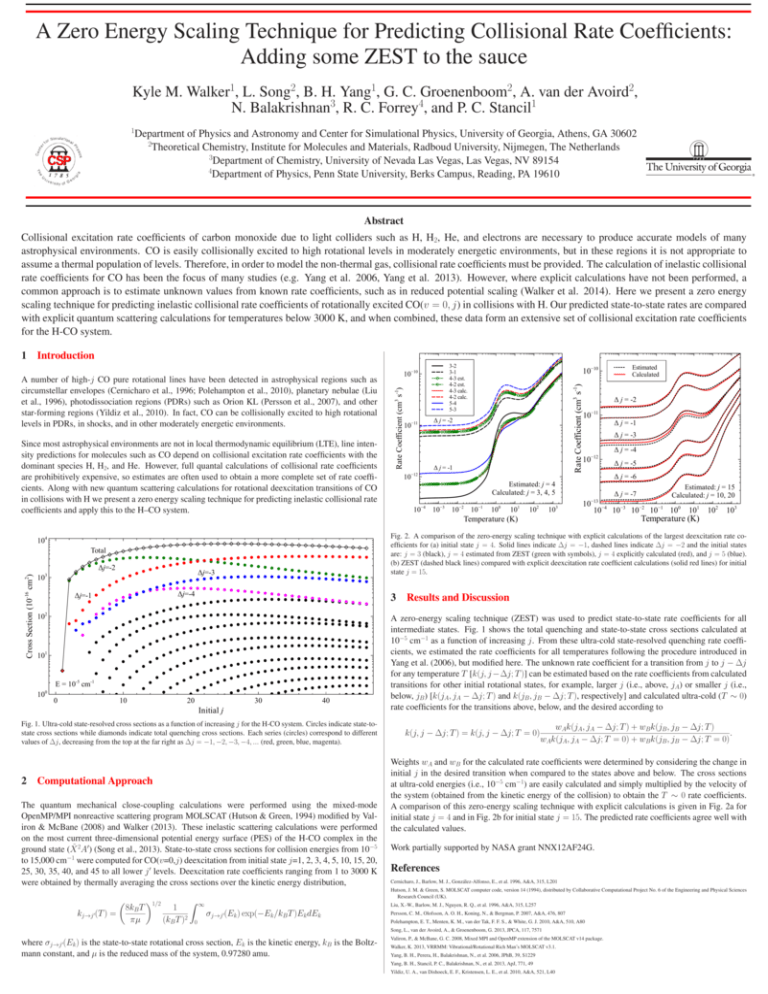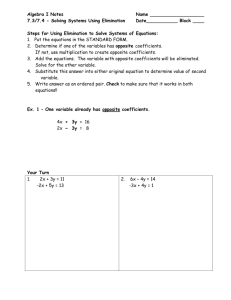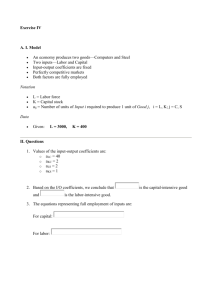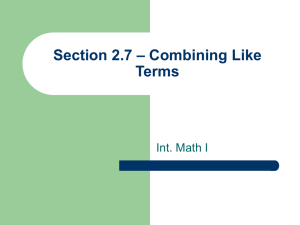Kyle M. Walker , L. Song , B. H. Yang , G. C. Groenenboom , A. van
advertisement

A Zero Energy Scaling Technique for Predicting Collisional Rate Coefficients: Adding some ZEST to the sauce 1 2 1 2 2 Kyle M. Walker , L. Song , B. H. Yang , G. C. Groenenboom , A. van der Avoird , 3 4 1 N. Balakrishnan , R. C. Forrey , and P. C. Stancil 1 Department of Physics and Astronomy and Center for Simulational Physics, University of Georgia, Athens, GA 30602 2 Theoretical Chemistry, Institute for Molecules and Materials, Radboud University, Nijmegen, The Netherlands 3 Department of Chemistry, University of Nevada Las Vegas, Las Vegas, NV 89154 4 Department of Physics, Penn State University, Berks Campus, Reading, PA 19610 Abstract Collisional excitation rate coefficients of carbon monoxide due to light colliders such as H, H2, He, and electrons are necessary to produce accurate models of many astrophysical environments. CO is easily collisionally excited to high rotational levels in moderately energetic environments, but in these regions it is not appropriate to assume a thermal population of levels. Therefore, in order to model the non-thermal gas, collisional rate coefficients must be provided. The calculation of inelastic collisional rate coefficients for CO has been the focus of many studies (e.g. Yang et al. 2006, Yang et al. 2013). However, where explicit calculations have not been performed, a common approach is to estimate unknown values from known rate coefficients, such as in reduced potential scaling (Walker et al. 2014). Here we present a zero energy scaling technique for predicting inelastic collisional rate coefficients of rotationally excited CO(v = 0, j) in collisions with H. Our predicted state-to-state rates are compared with explicit quantum scattering calculations for temperatures below 3000 K, and when combined, these data form an extensive set of collisional excitation rate coefficients for the H-CO system. 1 Introduction 10 −11 10 ∆ j = -2 ∆ j = -2 ∆ j = -1 10−12 10−11 ∆ j = -1 ∆ j = -3 ∆ j = -4 10−12 Estimated: j = 4 Calculated: j = 3, 4, 5 10−4 10−3 10−2 10−1 100 101 102 103 ∆ j = -7 Total Cross Section (10-16 cm2) 10 ∆j=-3 3 ∆j=-4 ∆j=-1 3 102 101 E = 10-5 cm-1 100 0 10 20 Estimated: j = 15 Calculated: j = 10, 20 10−13 −4 10 10−3 10−2 10−1 100 101 102 103 Temperature (K) Fig. 2. A comparison of the zero-energy scaling technique with explicit calculations of the largest deexcitation rate coefficients for (a) initial state j = 4. Solid lines indicate ∆j = −1, dashed lines indicate ∆j = −2 and the initial states are: j = 3 (black), j = 4 estimated from ZEST (green with symbols), j = 4 explicitly calculated (red), and j = 5 (blue). (b) ZEST (dashed black lines) compared with explicit deexcitation rate coefficient calculations (solid red lines) for initial state j = 15. 4 ∆j=-2 ∆ j = -5 ∆ j = -6 Temperature (K) 10 Estimated Calculated -1 −10 3 −10 Rate Coefficient (cm s ) Since most astrophysical environments are not in local thermodynamic equilibrium (LTE), line intensity predictions for molecules such as CO depend on collisional excitation rate coefficients with the dominant species H, H2, and He. However, full quantal calculations of collisional rate coefficients are prohibitively expensive, so estimates are often used to obtain a more complete set of rate coefficients. Along with new quantum scattering calculations for rotational deexcitation transitions of CO in collisions with H we present a zero energy scaling technique for predicting inelastic collisional rate coefficients and apply this to the H–CO system. Rate Coefficient (cm3 s-1) A number of high-j CO pure rotational lines have been detected in astrophysical regions such as circumstellar envelopes (Cernicharo et al., 1996; Polehampton et al., 2010), planetary nebulae (Liu et al., 1996), photodissociation regions (PDRs) such as Orion KL (Persson et al., 2007), and other star-forming regions (Yildiz et al., 2010). In fact, CO can be collisionally excited to high rotational levels in PDRs, in shocks, and in other moderately energetic environments. 10 3-2 3-1 4-3 est. 4-2 est. 4-3 calc. 4-2 calc. 5-4 5-3 30 40 Initial j Fig. 1. Ultra-cold state-resolved cross sections as a function of increasing j for the H-CO system. Circles indicate state-tostate cross sections while diamonds indicate total quenching cross sections. Each series (circles) correspond to different values of ∆j, decreasing from the top at the far right as ∆j = −1, −2, −3, −4, ... (red, green, blue, magenta). 2 Computational Approach The quantum mechanical close-coupling calculations were performed using the mixed-mode OpenMP/MPI nonreactive scattering program MOLSCAT (Hutson & Green, 1994) modified by Valiron & McBane (2008) and Walker (2013). These inelastic scattering calculations were performed on the most current three-dimensional potential energy surface (PES) of the H-CO complex in the ground state (X̃ 2A′) (Song et al., 2013). State-to-state cross sections for collision energies from 10−5 to 15,000 cm−1 were computed for CO(v=0,j) deexcitation from initial state j=1, 2, 3, 4, 5, 10, 15, 20, 25, 30, 35, 40, and 45 to all lower j ′ levels. Deexcitation rate coefficients ranging from 1 to 3000 K were obtained by thermally averaging the cross sections over the kinetic energy distribution, Results and Discussion A zero-energy scaling technique (ZEST) was used to predict state-to-state rate coefficients for all intermediate states. Fig. 1 shows the total quenching and state-to-state cross sections calculated at 10−5 cm−1 as a function of increasing j. From these ultra-cold state-resolved quenching rate coefficients, we estimated the rate coefficients for all temperatures following the procedure introduced in Yang et al. (2006), but modified here. The unknown rate coefficient for a transition from j to j − ∆j for any temperature T [k(j, j −∆j; T )] can be estimated based on the rate coefficients from calculated transitions for other initial rotational states, for example, larger j (i.e., above, jA) or smaller j (i.e., below, jB ) [k(jA, jA − ∆j; T ) and k(jB , jB − ∆j; T ), respectively] and calculated ultra-cold (T ∼ 0) rate coefficients for the transitions above, below, and the desired according to wAk(jA, jA − ∆j; T ) + wB k(jB , jB − ∆j; T ) . k(j, j − ∆j; T ) = k(j, j − ∆j; T = 0) wAk(jA, jA − ∆j; T = 0) + wB k(jB , jB − ∆j; T = 0) Weights wA and wB for the calculated rate coefficients were determined by considering the change in initial j in the desired transition when compared to the states above and below. The cross sections at ultra-cold energies (i.e., 10−5 cm−1) are easily calculated and simply multiplied by the velocity of the system (obtained from the kinetic energy of the collision) to obtain the T ∼ 0 rate coefficients. A comparison of this zero-energy scaling technique with explicit calculations is given in Fig. 2a for initial state j = 4 and in Fig. 2b for initial state j = 15. The predicted rate coefficients agree well with the calculated values. Work partially supported by NASA grant NNX12AF24G. References Cernicharo, J., Barlow, M. J., González-Alfonso, E., et al. 1996, A&A, 315, L201 Hutson, J. M. & Green, S. MOLSCAT computer code, version 14 (1994), distributed by Collaborative Computational Project No. 6 of the Engineering and Physical Sciences Research Council (UK). kj→j ′(T ) = 8kB T πµ 1/2 1 (kB T )2 Z ∞ Liu, X.-W., Barlow, M. J., Nguyen, R. Q., et al. 1996, A&A, 315, L257 σj→j ′(Ek ) exp(−Ek /kB T )Ek dEk 0 Persson, C. M., Olofsson, A. O. H., Koning, N., & Bergman, P. 2007, A&A, 476, 807 Polehampton, E. T., Menten, K. M., van der Tak, F. F. S., & White, G. J. 2010, A&A, 510, A80 Song, L., van der Avoird, A., & Groenenboom, G. 2013, JPCA, 117, 7571 where σj→j ′(Ek ) is the state-to-state rotational cross section, Ek is the kinetic energy, kB is the Boltzmann constant, and µ is the reduced mass of the system, 0.97280 amu. Valiron, P., & McBane, G. C. 2008, Mixed MPI and OpenMP extension of the MOLSCAT v14 package. Walker, K. 2013, VRRMM: Vibrational/Rotational Rich Man’s MOLSCAT v3.1. Yang, B. H., Perera, H., Balakrishnan, N., et al. 2006, JPhB, 39, S1229 Yang, B. H., Stancil, P. C., Balakrishnan, N., et al. 2013, ApJ, 771, 49 Yildiz, U. A., van Dishoeck, E. F., Kristensen, L. E., et al. 2010, A&A, 521, L40






